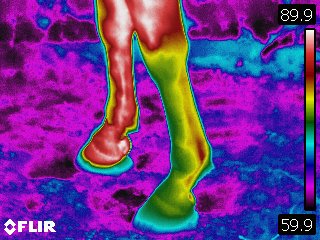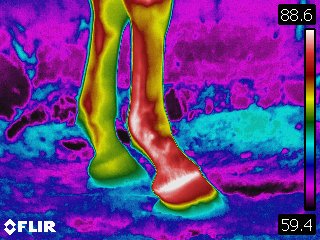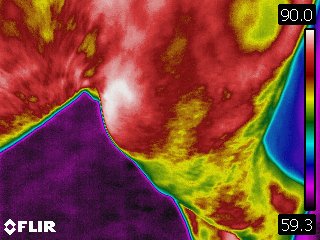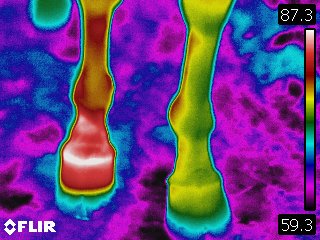Infrared Thermography
Thermographic imaging is an advanced, non-invasive technology that plays a crucial role in monitoring and maintaining horse health. By using our calibrated medical grade infrared camera to detect heat patterns and variations in temperature across a horse’s body, Equine Imaging Service (licensed in equine veterinary thermography) can interpret the results, providing valuable insights that are not visible to the naked eye. This safe and painless process can identify areas of concern early, allowing for prompt intervention and improved overall care.




What Does Thermographic Imaging Show?
Thermographic imaging reveals temperature changes that can indicate underlying health issues. Some of the key insights include:
-
Inflammation and Injury Detection: Areas of increased heat can signal inflammation, ligament strains, tendon injuries, or areas of trauma. Early detection allows for faster treatment and better outcomes.
-
Circulation and Nerve Function: Thermography can highlight poor circulation or nerve damage, which may present as cooler regions on the scan. Identifying these areas can assist in diagnosing issues like laminitis or nerve impingement.
-
Muscle Strain and Asymmetry: Subtle muscular imbalances or strain can be detected through temperature variations. This is especially useful for performance horses, where even minor imbalances can affect performance and long-term soundness.
-
Hoof Health: Thermography can identify temperature differences in the hooves, which may indicate issues such as abscesses, bruising, or early-stage laminitis.
-
Saddle Fit Issues: Poorly fitting saddles can cause pressure points and discomfort. Thermographic scans can show areas of excess heat or pressure, enabling precise adjustments to improve saddle fit and rider balance.
How Can Thermographic Imaging Help Keep a Horse Healthy?
Regular thermographic scans can be a proactive part of a horse’s health care plan. Here are some ways this technology supports equine well-being:
-
Early Detection of Problems: Catching potential health issues before they become serious helps prevent long-term damage and reduces the risk of chronic conditions.
-
Monitoring Recovery: For horses recovering from injury or surgery, thermography offers a non-invasive way to track healing progress and identify any setbacks.
-
Optimizing Performance: Performance horses benefit from thermography by identifying and addressing minor discomforts before they affect movement or competitive ability.
-
Customizing Care Plans: Thermographic insights allow veterinarians, trainers, and owners to tailor treatment, conditioning, and management plans to the horse’s specific needs.
-
Improving Comfort and Welfare: By identifying sources of discomfort like poorly fitting tack or subtle imbalances, thermography helps ensure horses remain comfortable and perform at their best.
IRT Applications:
- Pre-Race or Pre-Competition Screening
- Monitoring Soft Tissue Healing
- Whole-Horse Baseline Scans
- Pre-Purchase Evaluations
- Back Soreness & Injury
- Abscesses, Hoof Health & Balance
- Lameness Localization
- Saddle-Fitting Evaluation
- Ethics in Sport
- Kissing Spine
- Splints
Affordable Holistic Care
If your horse starts to display uncharacteristic tendencies such as dipping, inching or nipping when groomed ortacked-up, a poor or reduced performance, unevenness or unlevel gaits, is crooked to ride, carries his tail to one side, is disunited or bucking into canter or rearing or bucking when mounted, it may be due to pain. Infrared imaging can pinpoint where any issues are, allowing your chosen professional to administer a targeted course of treatment. Follow-up sessions ensure your horse returns to work at the optimal time, and allow you to easily and visually monitor the healing progress.
Imaging Packages
Personalized Imaging Plans
Imaging sessions include a report with images and comments/findings in pdf format. Personal web pages for horse history can be purchased, to allow viewing of larger images online, sharing of images and comments with trainers, veterinarians and therapists. See Page Plan pricing below.
Whole Horse Imaging Session
A whole-horse thermographic imaging session consists of whole-body and close up imaging of your entire horse, including topline and hooves from front and bottom. This is a comprehensive imaging package and will give you a complete picture of the physiology of your equine.
Cost: $225
Duration: 40 minutes
Lameness Evaluation
A lameness evaluation is used to see the physiological changes in your horse from activity. A complete imaging session is performed then the horse is exercised for approximately 15 minutes (less if too painful) and a second complete imaging session is performed. This highlights the changes in each aspect of the horse, allowing you to understand the complications and compensations causing lameness.
Cost: $295
Duration: 90 minutes
Saddle Fitting
A saddle fitting session consists of imaging of the horse’s back and sides and your saddle of choice cold, then again after the horse has been ridden for approximately 15 minutes. The imaging will show bridging, contact and pressure points that could inhibit performance and cause discomfort.
Cost: $150
Duration: 40 minutes
Personal Page with Larger Images
You’ll receive a personalized web page, optionally secured with a password, where all your imaging results—complete with comments and findings from various sessions, including fecal imaging if desired—will be stored. This page offers a convenient way to share your horse’s details with veterinarians, trainers, and therapists, while also allowing you to view enlarged versions of each image for 12 months after date of first imaging session.
Cost: $125
Renews Annually
Our equine thermography services provide non-invasive thermal imaging to identify variations in surface temperature that may indicate areas of inflammation, poor circulation, or other physiological changes. Thermography is intended as a complementary tool and is not a diagnostic procedure. The images and reports generated through thermography should not be interpreted as a definitive diagnosis. Only a licensed veterinarian is qualified to diagnose or treat medical conditions.
